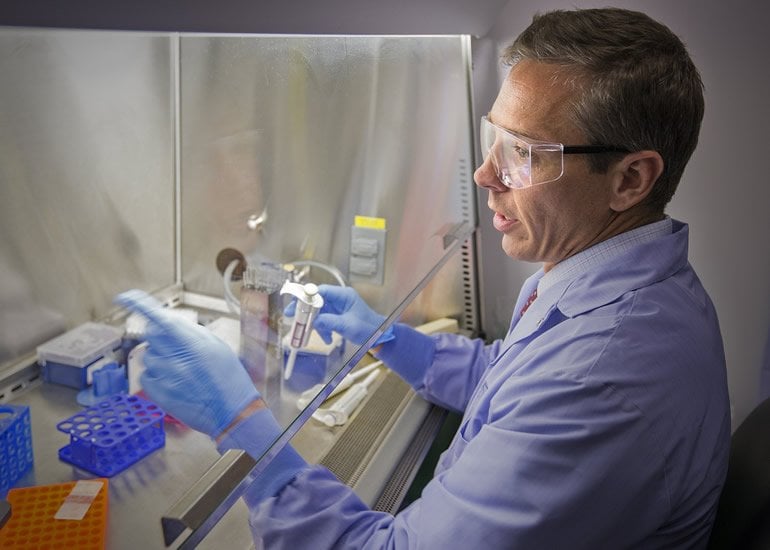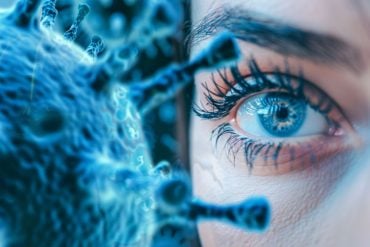Summary: Study reveals why some people with ALS are prone to developing autoimmune diseases. A genetic mutation that decreases the expression of C9orf72 causes the stimulation of interferon genes (STING) protein to become hyperactive. The hyperactivity leads to increased production of interferons. This can lead to systemic inflammation and the development of autoimmune diseases.
Source: Cedars Sinai
A study published today in the journal Nature could help explain why certain people who develop amyotrophic lateral sclerosis (ALS), a deadly neurological disorder also known as Lou Gehrig’s disease, are prone to autoimmune diseases.
ALS, which has no known cure, causes progressive degeneration of nerve cells in the spinal cord and brain. About 5,000 people are diagnosed with the disease each year.
The new research, led by Cedars-Sinai investigators, focuses on a mutation that decreases expression of a gene called C9orf72, the most common known cause of inherited ALS.
Investigators found that this mutation, found in about 10% of patients with ALS, causes the stimulator of interferon genes (STING) protein, a critical sensor of viral infections in the immune system, to become hyperactive. This hyperactivity led to increased production of interferons. Interferons are key for fighting viral infections, but constant, uncontrolled production of interferons can lead to systemic inflammation and development of autoimmune diseases.
“These findings support that patients with C9orf72 mutations have a fundamentally different set point of their immune system, with increased propensity to autoimmune diseases, and probably altered responses to viruses and other pathogens in the environment,” said Robert Baloh, MD, PhD, professor of Neurology and director of the Cedars-Sinai Center for Neural Science and Medicine.
Baloh is the corresponding author of the study, available online today and in the Sept. 3 print edition of the journal.
The C9orf72 mutation, which is believed to have originated in Northern Europe about 1,500 years ago and then spread as a result of Viking travels and wars, is also associated with frontotemporal lobar degeneration, a type of dementia that can accompany ALS.
For the study, investigators examined the brain tissue of laboratory mice with the C9orf72 mutation and and also blood and brain tissue from ALS patients who carried the gene. Results included:
- Immune cells isolated from the laboratory mice showed early spontaneous activation. In addition, a certain type of immune cell, called myeloid cells, had increased production of the interferons in response to activation of the STING protein.
- Tissues from ALS patients with the genetic mutation and frontotemporal lobar degeneration showed an elevated immune response compared with samples from patients with a different type of ALS.
Taken together, those findings suggested that ALS patients with the genetic mutation and frontotemporal lobar degeneration have an altered immune system because their reduced levels of C9orf72 cannot suppress the inflammation caused by the hyperactive STING protein, the investigators said.

“These results give us critical insights into the interplay of the immune system and neurodegenerative disease, ” said Nancy Sicotte, MD, chair of the Department of Neurology at Cedars-Sinai and the Women’s Guild Distinguished Chair in Neurology. “They have implications not only for ALS and frontotemporal lobar degeneration, but for other autoimmune and degenerative disorders affecting the nervous system.”
Interestingly, the investigators also found that mice with the C9orf72 mutation were more resistant to certain cancers, possibly as a byproduct of a hyperactive immune system. A similar decreased incidence of cancers has also been reported in ALS patients, but the reason remains a mystery.
“This study ties together research about a really important immune pathway and the genetics of ALS, linking neurodegeneration, autoimmune diseases and cancer,” Baloh said.
Baloh’s Neurodegenerative Diseases Laboratory is now studying how this gene mutation and heightened autoimmune response is linked to neurodegeneration. He said that understanding these connections may help investigators lay the groundwork for developing therapies for ALS.
Funding: This research was supported the National Institutes of Health under grants NS069669 and 1R21AI126368-01, the Robert and Louise Schwab family, the Cedars-Sinai ALS Research Fund and Arthritis Foundation grant AF2017-433570.
About this neurology research article
Source:
Cedars Sinai
Contacts:
Press Office – Cedars Sinai
Image Source:
The image is credited to Cedars Sinai.
Original Research: Closed access
“C9orf72 in myeloid cells suppresses STING-induced inflammation” by Madelyn E. McCauley, Jacqueline Gire O’Rourke, Alberto Yáñez, Janet L. Markman, Ritchie Ho, Xinchen Wang, Shuang Chen, Deepti Lall, Mengyao Jin, A. K. M. G. Muhammad, Shaughn Bell, Jesse Landeros, Viviana Valencia, Matthew Harms, Moshe Arditi, Caroline Jefferies & Robert H. Baloh. Nature.
Abstract
C9orf72 in myeloid cells suppresses STING-induced inflammation
Amyotrophic lateral sclerosis (ALS) and frontotemporal dementia (FTD) are neurodegenerative disorders that overlap in their clinical presentation, pathology and genetic origin. Autoimmune disorders are also overrepresented in both ALS and FTD, but this remains an unexplained epidemiologic observation1,2,3. Expansions of a hexanucleotide repeat (GGGGCC) in the C9orf72 gene are the most common cause of familial ALS and FTD (C9-ALS/FTD), and lead to both repeat-containing RNA and dipeptide accumulation, coupled with decreased C9orf72 protein expression in brain and peripheral blood cells4,5,6. Here we show in mice that loss of C9orf72 from myeloid cells alone is sufficient to recapitulate the age-dependent lymphoid hypertrophy and autoinflammation seen in animals with a complete knockout of C9orf72. Dendritic cells isolated from C9orf72−/− mice show marked early activation of the type I interferon response, and C9orf72−/− myeloid cells are selectively hyperresponsive to activators of the stimulator of interferon genes (STING) protein—a key regulator of the innate immune response to cytosolic DNA. Degradation of STING through the autolysosomal pathway is diminished in C9orf72−/− myeloid cells, and blocking STING suppresses hyperactive type I interferon responses in C9orf72−/− immune cells as well as splenomegaly and inflammation in C9orf72−/− mice. Moreover, mice lacking one or both copies of C9orf72 are more susceptible to experimental autoimmune encephalitis, mirroring the susceptibility to autoimmune diseases seen in people with C9-ALS/FTD. Finally, blood-derived macrophages, whole blood and brain tissue from patients with C9-ALS/FTD all show an elevated type I interferon signature compared with samples from people with sporadic ALS/FTD; this increased interferon response can be suppressed with a STING inhibitor. Collectively, our results suggest that patients with C9-ALS/FTD have an altered immunophenotype because their reduced levels of C9orf72 cannot suppress the inflammation mediated by the induction of type I interferons by STING.






